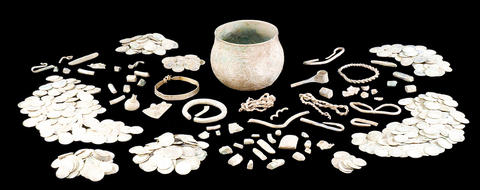A Viking treasure hoard of silver and gold, traded and looted from across Europe and as far afield as Asia and north Africa, and lost for more than 1,000 years, was revealed to public view again Thursday at the British Museum.
The find is one of the most spectacular recent discoveries from anywhere in the Viking empire: 600 coins, some unique, from as far as Samarkand in central Asia, Afghanistan, Russia and north Africa, hidden in a silver and gold pot.
"This is the world in a vessel," said Jonathan Williams, of the British Museum.

PHOTO: AP
The hoard was found in January near Harrogate, Yorkshire, by David and Andrew Whelan, father and son hobby metal detector enthusiasts. It was in a bare field due to be ploughed for spring sowing. They first found fragments of the lead sheeting which once protected it, then the pot itself. They could see coins and scraps of silver poking out, but heroically restrained themselves and brought the whole thing intact to their local archaeological finds officer.
The site seems then as now to have been an empty field: archaeologists scoured it for evidence, but found no trace of any settlement or structure.
The Whelans' patience - which helped preserve priceless clues as to how and when the hoard was hidden - was rewarded when the British Museum invited them to watch while conservator Hayley Bullock delicately tweezered the treasure out of the hard-packed ground. An X-ray had revealed only what she called "a lot of stuff."
Gradually the contents of the bowl spread out along the archaeologists' bench: a gold arm ring possibly made in Ireland, silver rings and brooches, dress ornaments, ingots, the chopped up scraps of silver which the Vikings used by weight as cash, and coins, many in superb condition, by the score. "If somebody asked me to fit it all back in now, I'm not sure I could," Bullock said yesterday.
The find goes some way to revive the more traditional image of the Vikings as fearsome raiders, after their recent rehabilitation as farmers, sailors and amiable trading folk in their kingdom of York and Northumbria.
The treasure was crammed into an exquisite silver pot, decorated with incised lions and deer, plated inside with pure gold because it once held the communion bread for some wealthy church in northern France.
Barry Ager, a British Museum expert on the Vikings in northern Europe, said it could have been looted, or given in unwilling tribute to persuade the raiders to go and loot somewhere else. A very similar one, possibly made by the same craftsman, was found in Lancashire more than a century ago. It arrived in Britain by equally dubious means.
The archaeologists believe the collection was probably assembled in England, as the contents are typical of other found hoards - though more spectacular.
It demonstrates the extraordinary geographical spread of precious metal being used as currency in Yorkshire, centuries after the fall of the Roman Empire. The Vikings could go anywhere that their long, narrow, shallow-keeled boats would carry them. They fought as mercenaries in armies across Europe and down into north Africa, including the siege of Constantinople, and crossed the steppes into Asia.
The valuables they collected, by whatever means, were bought, sold and traded all the way back along their sea lanes, to Viking cities such as Dublin, Liverpool and York.
The clue to why the Harrogate treasure was hidden lay in the bowl itself, archaeologists found. The latest coin was minted in 927 AD, by the Anglo Saxon king Athelstan, who was the first to proclaim himself "King of All Britain" - the most serious challenge to Viking power was closing on Harrogate, and the archaeologists are not surprised the owner was never able to go back to retrieve his hoard.
The find was formally declared treasure on Thursday by the North Yorkshire coroner, Geoff Fell, who said it was one of the most exciting cases he had ever encountered.
Its value has still to be determined by the treasure valuation committee, but the British Museum, and the York Museum Trust, which already has a superb Viking collection, are braced to try to raise more than US$2 million to acquire the hoard. Once a value has been established the finders will split the amount with the landowner.
The Viking hoard is part of a torrent of new treasure finds reported since metal detectors and archaeologists agreed a formal code of conduct, with the amateurs undertaking to report all finds.
The ploughed field had yielded nothing much before to the Whelans, apart from 20th-century junk. So David, a 51-year-old semi-retired businessman from Leeds, initially thought he had scanned a rusting bicycle or bit of broken cattle trough when his detector started bleeping.
"We were sweeping and I got a signal, so I took a couple of shovels full of soil and there was a stronger one," he said outside the coroner's court in Harrogate after the hearing. "I just kept going and going. A ball of earth rolled out of the side of the hole and I could see a coin stuck in it. We dug the hole out. We crouched down on our hands and knees."
Neither of the of the Whelans has great plans for the money they will receive.
David Whelan said: "We don't need owt. We've got all we want. It's a thing of dreams to find something like this."

In the next few months tough decisions will need to be made by the Taiwan People’s Party (TPP) and their pan-blue allies in the Chinese Nationalist Party (KMT). It will reveal just how real their alliance is with actual power at stake. Party founder Ko Wen-je (柯文哲) faced these tough questions, which we explored in part one of this series, “Ko Wen-je, the KMT’s prickly ally,” (Aug. 16, page 12). Ko was open to cooperation, but on his terms. He openly fretted about being “swallowed up” by the KMT, and was keenly aware of the experience of the People’s First Party

Aug. 25 to Aug. 31 Although Mr. Lin (林) had been married to his Japanese wife for a decade, their union was never legally recognized — and even their daughter was officially deemed illegitimate. During the first half of Japanese rule in Taiwan, only marriages between Japanese men and Taiwanese women were valid, unless the Taiwanese husband formally joined a Japanese household. In 1920, Lin took his frustrations directly to the Ministry of Home Affairs: “Since Japan took possession of Taiwan, we have obeyed the government’s directives and committed ourselves to breaking old Qing-era customs. Yet ... our marriages remain unrecognized,

During the Metal Ages, prior to the arrival of the Dutch and Chinese, a great shift took place in indigenous material culture. Glass and agate beads, introduced after 400BC, completely replaced Taiwanese nephrite (jade) as the ornamental materials of choice, anthropologist Liu Jiun-Yu (劉俊昱) of the University of Washington wrote in a 2023 article. He added of the island’s modern indigenous peoples: “They are the descendants of prehistoric Formosans but have no nephrite-using cultures.” Moderns squint at that dynamic era of trade and cultural change through the mutually supporting lenses of later settler-colonialism and imperial power, which treated the indigenous as

Standing on top of a small mountain, Kim Seung-ho gazes out over an expanse of paddy fields glowing in their autumn gold, the ripening grains swaying gently in the wind. In the distance, North Korea stretches beyond the horizon. “It’s so peaceful,” says the director of the DMZ Ecology Research Institute. “Over there, it used to be an artillery range, but since they stopped firing, the nature has become so beautiful.” The land before him is the demilitarized zone, or DMZ, a strip of land that runs across the Korean peninsula, dividing North and South Korea roughly along the 38th parallel north. This